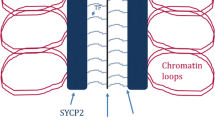Abstract
The four synaptonemal complexes (SC) in Meloidogyne nataliei (n=4) have normal, tripartite morphology, although the total width of the SC is only 50 nm. Each SC is attached at both ends to the nuclear envelope and there is no bouquet formation at pachytene. Pairing of homologues is regular but not complete, as there is one region on each bivalent where the SC is not formed. This region may be the ‘fusion point’ of telomeres of nonhomologous chromosomes, since it is assumed that M. nataliei has been derived from an ancestral strain (n=8) via chromosomal fusions. In each pachytene nucleus there is a nonmembranous, vacuole-like structure of unknown function located in the nucleoplasm adjacent to the nucleolus, and of approximately the same volume as the nucleolus. The fact the SC structure of M. nataliei is strikingly different from that of most Meloidogyne species suggest that M. nataliei may not belong to the same phyletic group as the genus Meloidogyne.
Similar content being viewed by others
References
Ashley T (1979) Specific end-to-end attachment of chromosomes in Ornithogalum virens. J Cell Sci 38:357–367
Dancis BM, Holmquist GP (1977) Fusion model of telomere replication and its implications for chromosomal rearrangements. Chromosomes Today 6:95–104
Gillies C (1975) Synaptonemal complex and chromosome structure. Annu Rev Genet 9:91–109
Goldstein P (1981) Sex determination in nematodes. In: Zuckerman B, Rhode R (eds) Plant parasitic nematodes, vol. III. Academic Press, NY, pp 37–60
Goldstein P, Triantaphyllou AC (1978a) Occurrence of synaptonemal complexes and recombination nodules in a meiotic race of Meloidogyne haplu and their absence in a mitotic race. Chromosoma 68:91–100
Goldstein P, Triantaphyllou AC (1978b) Karyotype analysis of Meloidogyne hapla by 3-D reconstruction of synaptonemal complexes from electron microscopy of serial sections. Chromosoma 70:131–139
Goldstein P, Triantaphyllou AC (1980) Karyotype analysis of the plant-parasitic nematode Heterodera glycines by electron microscopy. II. The tetraploid and an aneuploid hybrid. J Cell Sci 43:225–237
Goldstein P, Triantaphyllou AC (1981) Pachytene karyotype analysis of tetraploid Meloidogyne hapla females by electron microscopy. Chromosoma 84:405–412
Goldstein P, Triantaphyllou AC (1982) The synaptonemal complexes of Meloidogyne sp.: Relationship of structure and evolution of parthenogenesis. Chromosoma 87:117–124
Hartley SE, Horne MT (1984) Chromosome relationships in the genus Salmo. Chromosoma 90:229–237
Renkawitz-Pohl R, Bialojan S (1984) A DNA sequence of Drosophila melanogaster. Chromosoma 89:206–211
Rubin G (1978) Isolation of a telomeric DNA sequence from Drosophila melanogaster. Cold Spring Harbor Symp Quant Biol 42:1041–1046
Staller-Young B, Pession A, Traverse KL, French C, Pardue ML (1983) Telomere regions in Drosophila share complex DNA sequences with pericentric heterochromatin. Cell 34:85–94
Steinemann M (1984) Telomere repeats within the neo Y chromosome of Drosophila miranda. Chromosoma 90:1–5
Triantaphyllou AC (1983) Cytogenetics aspects of nematode evolution. In: Stone AR, Platt HM Khalil LF (eds) Concepts in nematode systematics, vol. 22. Academic Press, London, pp 55–71
Triantaphyllou AC (1984) Polyploidy in meiotic parthenogentic populations of Meloidogyne hapla and a mechanism of conversion to diploidy. Rev Nematol 7:65–72
Triantaphyllou AC (1985) Gametogenesis and the chromosomes of Meloidogyne nataliei: Not typical of other root-knot nematodes. J Nematol 17:1–5
Warster DH, Benirschke K (1968) Chromosome studies in the superfamily Bovoidea. Chromosoma 25:152–171
Westergaard M, von Wettstein D (1972) The synaptinemal complex. Annu Rev Genet 6:71–110
White MJD (1973) Animal clytology and evolution. Cambridge University Press
Author information
Authors and Affiliations
Rights and permissions
About this article
Cite this article
Goldstein, P., Triantaphyllou, A.C. The synaptonemal complex of Meloidogyne nataliei and its relationship to that of other Meloidogyne species. Chromosoma 93, 261–266 (1986). https://doi.org/10.1007/BF00292747
Received:
Revised:
Issue Date:
DOI: https://doi.org/10.1007/BF00292747




